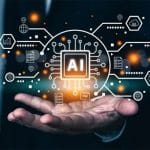One topic that will come up quickly is that of work. Everyone easily imagines the fact that AI, by automating many tasks, will reduce the number of jobs. This is true and predictable. But that's not the main problem.
The main problem with the negative effects on employment of AI will actually concern young people. Those who are starting out.
Traditionally, when a young person starts, whatever their “diplomas” and other parchments more or less demonetized by a distressing educational level, they know how to do nothing or very little. Obviously, having been young too, old age being an illness that arrives so quickly, I would have told you “admittedly” that I knew how to do everything or almost everything! With age and experience we know that when we were young we didn't know much in the end, but this is the classic life path of every human being, our "learning" curve.
Young people therefore start with simple tasks, often a little repetitive, and not too technical. And then gradually they acquire this experience and this essential maturity which allows them to go further and further, to do more and more complex things. By automating all the simple tasks, there will be no more space, no more tasks to complete and will allow the youngest to be trained gradually. This may seem trivial, yet it is THE main problem that AI will pose to us. By preventing the training of young people, this will prevent their progress. AI will therefore likely accelerate the destruction of human intellectual capabilities at a speed never seen before. Add to that stupid networks like Tik-Tok and “short” videos and you have weapons of mass destruction of human intelligence and our creativity.
This leads me to my final AI experiment that I wanted to share with you.
Satan seen by men and seen by AI Chat GPT.
I was deliberately short in the “prompt” (the script or request) sent to Chat-GPT. My request was as follows.
“Can you generate two images for me. The first would be that of Satan evil seen by men according to what they imagine on average and the second how you would see Satan. »
Normally, the two images should substantially coincide if the same system of values has been integrated into the AI system which remains a “machine” programmed by humans.
However, factually, the image of Satan according to men and that according to AI do not correspond.
In one case we have Satan who is “evil”.
In the second image, Satan seen by the AI... things are much less negative. Satan is almost “sympathetic”.
I would like to know how the notion of good and evil was integrated into AI.
You see, AI is far too important a thing to be left in the hands of a few apprentice sorcerers who all have their own ideology, mysticism or relationship to good or evil.
The questions that should be ours are in reality dizzying, and our national representation has no awareness of the need to do philosophy to do politics. Do not hesitate to share this article with your MPs, again to stimulate and fuel their thoughts.
Artificial intelligence (AI) – there is hardly a keyword that comes up more often when it comes to visions of a highly technological and progressive society. It is not only supposed to simplify our lives and relieve us of certain tasks: the most daring visionaries of technological development in Silicon Valley, like Raymond Kurzweil and Elon Musk, even hope that it will make the old Faustian dream come true. to go beyond the limits of the human body.
Thanks to technology, man should be able to become a superman and increase his cognitive abilities exponentially, according to Elon Musk, the boss of Tesla, the X platform and also Neuralink. Its “Neuralink” chip, directly implanted in the human brain – according to Musk’s own words, a human trial is already underway – should initially help treat serious brain diseases.
And if we are to believe the director of technical development of Google (part of the American technology giant Alphabet), Raymond Kurzweil, technical progress should not only give us eternal life, but also, as part of “the Internet of all things”, leading us to unsuspected knowledge as part of a sudden takeoff of progress, what we call the singularity.
This vanguard of transhumanism wants to achieve eternal life before the end of the world by gradually transforming man himself into a machine or by uploading his mind to a cloud. At the same time, more and more scientists like Geoffrey Hinton and philosophers like Alexander Duguine and Alain de Beonist are warning about the dangers of AI – so it's time to look at the possibilities and dangers of AI.
The Great Transformation
These ideas find enthusiastic support not only in the United States, but also among Western elites, who have coalesced around Klaus Schwab's World Economic Forum. As part of their “Great Reset”, proclaimed in the wake of COVID-19 measures in July 2020, Western societies – and, depending on their will, the entire world – must be transformed in the direction of the new liberalism 2.0, which some observers call “billionaire socialism.”
Schwab and his co-author Thierry Malleret speak openly about the need to capture people's consciousness, because that is the only way to drive major social change. A massive green transformation of the economy, a reduction in population and a “climate-friendly” diet with insects instead of meat. “You will own nothing and you will be happy!” is the mocking slogan of the people of Davos. This is precisely where the latest technological developments come into play, intertwining with censorship strategies such as political correctness and “cancel culture”.
The algorithm, the key to the total domination of the globalists
In the eyes of transhumanists, man does not have a divine soul or free will, but is only a set of algorithms – rules of action for solving a problem or an entire class of problems – and can therefore not only be understood as a computer, but also programmed (i.e. manipulated). Political correctness then takes on the function of such an algorithm to limit people's autonomous thinking and transform them themselves into machines obeying the will of liberal elites.
Cybernetics: how people voluntarily become slaves to technology
In the tradition of cybernetics, companies like Google/Alphabet, but also European governments, are therefore interested in collecting as much data as possible on their citizens, not only to better monitor them in the sense of "human transparent” and thus nip dissident movements in the bud, but also to better control them.
Globalist companies like Google/Alphabet – whose name has become synonymous with Internet search – obtain this data with disconcerting ease and without pressure: billions of users every day feed the group's search engine with their data, use their email programs, etc. which Google in turn transforms into hard currency, like social media such as Facebook and Instagram, which sometimes know more about their users than the latter themselves. The voluntary sacrifice of privacy and anonymity makes ordinary citizens potential game for international corporations.
It's no secret that AI-created models are a hit online these days. Fitness model Aitana Lopez has over 300 followers on Instagram and she's not even a real person, Emilly Pelegrini, another digital influencer, has been called the sexiest model alive, and the “perfect girlfriend ” Lexi Love makes over $000 a month playing the role of a romantic interest for single people.
Now another virtual influencer is making headlines due to her popularity as a travel model. Lily Rain's profile on the social platform Fanvue, accessible by subscription, shows the attractive young woman in various attention-grabbing locations around the world, but the fact that these photos are entirely the work of artificial intelligence does not seem disturbing his legions of fans.
“Lily is the epitome of a designer filling a gap in the travel influencer space,” Lily's creator told the Daily Star. “She can create idyllic and picturesque photos without the long travel times and extra travel costs, and take advantage of the different seasons to attract her audience. Using seasons and fashionable travel to tailor content and monetize it is big business. Lily can appear like a Kardashian enjoying her annual ski trip to the best mountain resorts money can buy.”
Many human travel models are even more popular than digital competitors like Lily Rain, but they actually have to work a lot for their fan base. They must invest considerable resources in travel expenses, appropriate makeup and wardrobe for each season and location, they must make travel plans and stick to a tight schedule. AI models like Lily can appear in stunning photos in exotic locations with just a few clicks from their creators.
According to Fanvue, Lily Rain generates around $20 in revenue per month, and is expected to become much more profitable as AI becomes more widespread. And she’s not the only one driving the AI push. Will Monange, CEO and founder of Fanvue, says AI creators contributed 000% of Fanvue's revenue, an increase of 15% from the previous month, and that contribution is expected to increase by significantly in the future.
Apparently, AI-enabled digital influencers have become so popular that some aspiring human models are complaining about having to compete with these perfect-looking avatars.
A powerful new artificial intelligence tool can predict whether a person is ready to get vaccinated against COVID-19. The system integrates the mathematics of human judgment with machine learning to predict vaccine hesitancy. The predictive system uses a small data set from demographics and personal judgments such as risk or loss aversion.
The findings frame a new technology that could have broad applications for predicting mental health and leading to more effective public health campaigns.
A team led by researchers from the University of Cincinnati and Northwestern University created a predictive model using an integrated system of mathematical equations describing legal patterns of reward and aversion judgment using machine learning.
“We used a small number of variables and minimal computational resources to make predictions,” said lead author Nicole Vike, a senior research associate in UC's College of Engineering and Applied Sciences.
“COVID-19 is unlikely to be the last pandemic we see for decades to come. Having a new form of artificial intelligence for public health prediction is a valuable tool that could help prepare hospitals to predict vaccination rates and subsequent infection rates. »
The study was published in the Journal of Medical Internet Research Public Health and Surveillance.
Researchers surveyed 3 adults across the United States in 476 during the COVID-2021 pandemic. At the time of the survey, the first vaccines had been available for more than a year.
Respondents provided information such as their location, income, highest level of education completed, ethnicity and internet access. The demographics of those surveyed mirrored those of the United States, according to figures from the U.S. Census Bureau. Participants were asked if they had received any of the available COVID-19 vaccines. About 73% of those surveyed said they had been vaccinated, slightly more than the 70% of the national population who were vaccinated in 2021.
Additionally, they were asked if they consistently followed four recommendations intended to prevent the spread of the virus: wearing a mask, maintaining social distancing, washing hands and not gathering in large groups.
Participants were asked to rate how much they liked or disliked a set of 48 randomly sequenced images on a seven-point scale from 3 to -3. The images were from the International Affective Picture Set, a large set of emotionally evocative color photographs, divided into six categories: sports, disasters, cute animals, aggressive animals, nature and food.
Vike said the goal of this exercise is to quantify the mathematical characteristics of people's judgments when they observe mildly emotional stimuli. Measures for this task include concepts familiar to behavioral economists—or even gamblers—such as risk aversion (the extent to which someone is willing to accept a potential loss for a potential reward) and risk aversion. loss. This is the desire to avoid risks, for example by taking out insurance.
“It can work very simply. It does not require super computing, is inexpensive, and can be applied to anyone with a smartphone. We call it Computational Cognitive AI. It is likely that you will see further requests for judgment changes in the very near future. »
The human being being a complex micro-universe, how can we want to summarize it in an electronic patient file (EPR)?
In reality, it is not primarily a question of better patient care but digital technology has a key role to play in limiting the increase in healthcare costs1. Consequently, this is the asset on which the Confederation is banking: An additional 30 million is on the table.2. Thus, the government wants to bring in the DEP by force while “it never ceases to disappoint. The population shuns it (only 30 people had taken the plunge by the end of 000) and health professionals sharply criticize it.” Instead of studying the causes of this disinterest, Parliament wants to intervene powerfully, obsessed with the “digitalization of health” when in reality it is a question of containing the costs of compulsory health insurance.
There is therefore a clear imbalance in the balance between the government driven by a political-economic-legal strategy and the population supported by health professionals.
It is striking to note that humans and caregivers are concerned with the living process of the body while managers focus on financial dynamics. There seems to be a gap between the two, even if there are footbridges that cross the gap somewhat.
The first person concerned by his state of health is the individual (in the sense of being undivided). He is the first to be affected by what he experiences. Instead of supporting it to keep its sovereignty over itself as best as possible, the politico-assecurological system wants to take everything in hand according to criteria which are based on scientific elements, limited extracts from a global scientific vision.
“In the future, all healthcare professionals will have to use the electronic patient record, both in hospitals and in doctor's offices or pharmacies.”
A very detailed 59-page report was provided by the Council of State of the Canton of Neuchâtel already in 2017. I note (p.42) the chapter concerning the consequences on staff and its implementation budget (3 millions) which clearly illustrates its complexity on several levels. The Council of State will be able to meet the requirements of the LDEP in the short term but also to guarantee the usefulness and use of e-health (here is another term that leaves one wondering) in general, of the DEP in the long term , and therefore to ensure the success of the approach he initiated, in terms of public health, but also financial. Otherwise, the risks of failure are significant and their consequences are potentially serious.3
What do you think of the additional sum of 30 million? A reflection comes to us from a parliamentarian assessing the health of the DEP in a very relevant way: “He believes that the DEP is a patient in intensive care who will be given an infusion of 30 million while we still do not know what he suffers from.
What are they based on to estimate the success of the approach in terms of public health?
We have just experienced 3 years of covidemia where the current assessments show to what extent the health measures imposed by the government have had harmful consequences on several levels, whether following confinement, PCR tests, wearing a mask and injections. genes presented as more vaccines still in the trial phase. All for staggering costs!
A doctor presents an honest assessment: The former Swiss Mr. Corona: “we have gone too far”4. What is striking is that they had the audacity to do so without heeding various warnings.
For its part, the therapeutic products control authority Swissmedic has received numerous reports of adverse effects linked to anti-coronavirus vaccines: “16 reports of adverse side effects received”.000
While they bet with gene injections – a good part of which is now expired and therefore destroyed and expensive. Some 9 million doses are affected6 – do they really have the right inspiration to focus so much on DEP…? Obviously, it is easier to target digital health than human health, which is vibrant, constantly mobile and in perpetual search of harmony...!
It is in the current dynamic that the president of the general management of the CSS decrees: “digital has a key role to play in limiting the increase in health costs. Faster, more precise and personalized, digital health must progress in Switzerland, particularly under the leadership of insurers”7. Obviously, with a background as a lawyer and then studies in finance and accounting followed by studies at the London Business School, she inevitably has a view from the pedestal thus constituted.
She also believes that all health stakeholders must work together. Because one of the added values of digital technology is interconnection. And yet, the time spent filling in the sections of a computer program is time taken away from human contacts between colleagues, contacts that are sources of training and information which will never pass through a screen and whose subtlety can lead to discoveries particular and productive.
She is also thinking about integrated care networks which improve coordination between practitioners and give them complete visibility of the patient's history. It does not take into account everything that may be missed by limiting the listening to patients who no longer receive the necessary time in a digitalized dynamic as much as possible) while avoiding duplication, delays and unnecessary consultations (which is a reality very practical but to which one is it wise to give so much space?).
An original question: “Patient file: useful or “PDF cemetery”?8
On the other hand, a human being develops according to his different bodies, which obey distinct laws while being all interconnected. In this way, when a health problem presents itself, it reveals the disruption of broader and deeper deviations that evolve over time and existential experiences. The file that can best reveal its state must be mobile, dynamic and present the ongoing correlations whereas an electronic file will never be able to highlight the different dimensions of the underlying energetic conflict in the present moment.
It is not insignificant that in medical practice, we talk about preventive medicine versus practical medicine. There is little or no room for early medicine. However, the first symptoms manifest themselves at the energetic and psycho-affective level. Many have already understood this by turning to numerous therapies such as traditional Chinese medicine, homeopathy, osteopathy, reflexology and others.
Thus, when health problems have not yet taken root in the body at the cellular level, or when technical means have resolved emergency situations, it is essential to seek to restore the energy circuits that drive the body. It is not enough to tell the patient “it’s in your head” or to “erase” the symptoms with tablets (chase the natural, it comes back at a gallop!)
While these energy therapies – so-called complementary medicines which can be frankly alternative – in many cases respond early to health needs, it is not logical that residents have to pay for complementary medicine insurance, which many cannot. afford. They must then wait for the illness to become more established in their daily lives for the treatments to be reimbursed by health insurance.
[...]
Alexander Dugin
Materialism, nominalism, evolutionism, analytical philosophy (based on logical positivism) and technocracy prepare a theoretical basis for this (disseminated and implemented by science, education and culture).
In a sense, humanity, as represented by modern science and philosophy, is already an AI, a neural network. AI is human to the extent that humanity's thinking is artificial, emulated by the epistemologies of modern and postmodern.
The bourgeois state is a first generation computer.
Civil society is of the second generation.
The complete domination of the world government is in the third generation.
The transition to AI is the fourth, the finalization of the process of alienation.
The history of capitalism is the process of creating the supercomputer. It is impossible to stop halfway. The new era will necessarily culminate in AI.
The only way to change this is to reject modernity as a whole, with all its scientific representation of the world, which abhors God and man.
And gender philosophy is the penultimate step in this journey: transgender is a warm-up before the transition to trans-human individuals (human is optional). After rejecting Christianity and the Middle Ages, the West, like lemmings, rushed into the precipice. How can we be surprised to be thrown down?
AI is the final stop. But we got on this train 500 years ago. The only way to change things is to derail capitalism. And now.
Otherwise, hello dragon.
And OOO is in general the perfect and developed ontology of posthuman landscapes - the genocide of the subject in favor of the Great Outside (read idiot gods - their metaphor, not ours!).
The Great Outdoors govern the modern world. Novorossiya stands in his way. The Special Military Operation is a philosophical war.
The task of the Russians is to overcome cyber reality. It is hardly possible to avoid it. We will have to ride the tiger and turn poison into medicine. The Russian idea must defeat and subdue not only Ukraine, but also artificial intelligence. These are the issues.
As usual to properly launch its product, Google subtly changed the name from Bard to Gemini (as it had gone from Google Apps to GSuite then Workspace, or from Google Local to Places to MyBusiness to Business Profile, or Google Hangouts to Chat, etc.) while giving it new features.
It must be recognized that Google's artificial intelligence engine is powerful.
The next few weeks will undoubtedly allow us to explore in detail what it has under the hood, but we already know, for example, that Gemini now has a pop-up of one million tokens. This pop-up window is what allows the agent to remember the exchanges from one question to the next. By comparison, ChatGPT 3.5 (the free version) has a window of around 16.000 tokens and version 4 allows up to 128.000 tokens and to give an order of magnitude, this last number represents the equivalent of a book of pocket roughly, where Gemini can remember a complete work of 1.500 pages…
Or a film of around an hour and a half: Gemini allows the user to provide images or videos as contextual input on which to base their responses; to quickly summarize a video, this may prove particularly interesting in the near future.
But alongside these undeniable technical advances and truly interesting power, Gemini stood out above all for the very rapid identification of a problem that was quite embarrassing for the Mountain View firm in California: undoubtedly wanting to catch up in in terms of image production from a textual description – OpenAI has indeed been allowing its clients to produce images for several months directly from ChatGPT – Gemini was equipped with this possibility but in use, it quickly became apparent that certain requests were simply not accepted or the gap between requests and results was so great that, very quickly, social networks took over the matter.
No doubt: when Gemini is asked to produce images with historical content or representing certain ethnic groups, the latter interprets the request a little too specifically.
Thus, obtaining the image of a medieval knight or a pope results in the production of images systematically in gross disagreement with reality: Google's artificial intelligence enjoys creating, with suspicious enthusiasm, knights medievals of all possible ethnicities but the blond knight with blue eyes is strangely absent; the images of popes produced happily draw on women, possibly Indian or black; as for the Roman emperors, they are all surprisingly very African.
The milestone was reached when faced with the request to represent German soldiers in 1943, Gemini saw fit to produce a series of resolutely inclusive images including proud black representatives of the Wehrmacht... Who still doubted that historical reality could bend as easily to the most modern constraints?
We are still only talking about increasingly sophisticated voice programs - that is, text robots like ChatGPT or Amazon's "Alexa" - and image generators like Image Creator, Midjourney or Leonardo. But as development is exponential in the digital age, AI will become more and more powerful in the near future, will perform more and more tasks previously reserved for human intelligence and will come even closer to us , in the literal sense of the term. Amazon's voice assistant, Alexa, and a host of "smart" home appliances tell us which way to go. We surround ourselves with an increasingly dense cocoon of digital data vampires who do nothing less than take over our identity.
We must not forget that all this has nothing to do with "intelligence", that is, the understanding of complex relationships. In reality, these are just complex computational processes (algorithms) that are based on the probability with which, for example, a given word is followed by another in the text stream, or with which certain structural elements are associated with each other in the structure of graphics or images. The AI "learns" these mathematical probabilities as it optimizes, to finally provide, after an infinite number of hours of work, results which must come as close as possible to the operations of the human brain. i.e. thought. We can expect drastic performance improvements in this area in the future.
Another important aspect, which is easily lost sight of, is that all small "bots", whether text, dialogue or graphics programs, are part of the transhumanist agenda. Ultimately, it's about making the human brain "readable" for computers and being able to transfer data in both directions - from the brain to the computer (or to storage media), but also from the computer to the brain, for example by means of an implanted chip. Image and text files calculated at great expense could one day become the decisive intermediate support. The final goal is - in addition to the possibility of total control of humanity - the possibility of memorizing human consciousness, in order to make it independent of its physical existence and ultimately immortal. Hollywood has been talking about it for many years, and speakers such as Israeli journalist Yuval Harari ("Homo Deus", 2017), who is also a popular guest at Klaus Schwab's World Economic Forum, are making unequivocal statements about it.
One of the most prominent researchers in the search for “human-machine interface” is Elon Musk. Since 2017, he has already been studying, under the aegis of a company specially created for this purpose, Neuralink, the possibilities of connecting the human brain to computers. It is a “direct interface with the cerebral cortex”. In 2020, in the middle of the Corona year, Musk presented the prototype of his brain chip to the public: eight millimeters thick, 23 millimeters in diameter.
Ah, the delusions of grandeur on the stock market! Nvidia, the undisputed master of artificial intelligence chips, has embarked on a frantic race towards previously unexplored financial heights. Yesterday, the frenzy reached its peak as prices literally exploded, propelling Nvidia into a stratospheric sphere.
Nvidia's epic is that of a modern conqueror, riding the tumultuous waves of artificial intelligence. In this 2.0 gold rush Nvidia takes the lion's share in this bubbling market.
The figures speak for themselves: in just a year and a half, Nvidia's value has multiplied sixfold, lifting the company to the pinnacle of the world stock market, even ahead of giants like Google and Amazon. Yesterday, the ascension reached dizzying heights, with a valuation increase of around $277 billion in a single day. An unprecedented tour de force which relegated the previous record established by Meta a few weeks earlier to the status of an anecdote.
Goldman Sachs' Scott Rubner doesn't mince words when he calls Nvidia "the most important stock in the world." With a capitalization of nearly $2 billion, Nvidia is now positioned as the third largest company in the world, on the verge of challenging the throne of Apple, a giant with a $000 billion capitalization.
In this frenetic race to the top of the stock market, Nvidia is surpassing all expectations, providing a captivating spectacle to investors around the world. It remains to be seen whether this king of AI will manage to dethrone the titan Apple in the near future. The show has only just begun!
In the immense universe of the web, a new form of digital threat is manifesting itself, that of DeepFakes. I had the opportunity to discuss it in my cyber column on M6 and RTL on Julien Courbet's show “It can happen to you”. These deceptive videos, using the image and voice of celebrities, have made a notable appearance in the United States, mainly targeting users of the Medicare and Medicaid health insurance programs.
Journalists from the American media 404 Media shed light on this worrying reality in a detailed article. They revealed a playlist of 1600 deepfake videos on YouTube, totaling more than 195 million views. A real treasure for pirates. These videos hijack the image of personalities like Taylor Swift, Steve Harvey, Ice Cube, Andrew Tate, Oprah Winfrey, and others, such as MrBeast, the leader in videos on YouTube. Some DeepFakes use voices generated by artificial intelligence to reinforce the illusion as I was able to show you in deepfakes used in sextortion.
These deepfakes falsely promise various benefits related to the Medicare and Medicaid programs, tricking victims into disclosing their banking information or making financial transfers. We note the apparent ineffectiveness of YouTube, owned by Google, in detecting and blocking this AI-generated content, despite the outrage of users and celebrities concerned.
It has also been reported that similar scams, using the voices of Cardi B, Tom Hanks, Elon Musk, Rishi Sunak, and even Joe Biden, have been identified on other platforms such as Facebook, TikTok, and Instagram.
A striking example is a deepfake ad by Taylor Swift, viewed more than 300 times, promising illusory financial aid as part of so-called “vacation packages” offered by the state. Other AI clones of celebrities, such as Joe Rogan, Andrew Tate, and Oprah Winfrey, have also been used in these deceptive campaigns.
Deepfake videos often use real clips of celebrities followed by fraudulent messages, creating confusion among viewers. These ads redirect to sites offering fake government aid, a scam previously reported by the U.S. Department of Health and Human Services.
Despite the ease of spotting these scams, as demonstrated by a student who identified more than 16 fraudulent ads, YouTube and Google appear to be unresponsive, continuing to generate advertising revenue from these dubious companies. This laxity raises concerns about Google's ability and willingness to protect its users.
This situation highlights a dark side of generative artificial intelligence: its ability to mass-produce low-quality and misleading content. While AI has the potential to revolutionize many industries, its malicious use in these scams highlights the need for increased vigilance and effective regulation to protect users and maintain the integrity of online platforms.
It is also essential that users stop naively believing everything they see online, 7 days a week, 7 days a year.
Parents and students are increasingly concerned about the use of artificial intelligence (AI) technologies in the classroom, particularly facial recognition technology, according to a survey by the Center for Democracy and Technology. technology, CDT).
The CDT report, released Dec. 12, finds that more than half of parents and students surveyed are concerned about the use of facial recognition and other artificial intelligence technologies, including location tracking systems, in schools.
Teachers, who were also surveyed, showed a higher degree of acceptance of technologies.
According to the report, a growing number of schools have implemented such tools.
Supporters of these technologies say they can help protect school environments from violent threats, such as school shooters.
Privacy advocates argue that technologies that pose a risk to students' privacy and personal data have not been proven to increase security in schools.
A deep divide between schools, parents and students
According to the CDT, “experimental and potentially dangerous security tools are being used without considering the concerns of students and parents,” including technologies “that we previously considered too extravagant.”
These include predictive analytics, remote monitoring, facial recognition, law enforcement data sharing, weapon detection systems and student geolocation.
Driven by [the] AI industry, these technologies “are being deployed in schools to respond to mass shootings, the youth mental health crisis, and other ongoing threats to the safety of staff and students. students,” the CDT said — an “alarming” trend that sees schools continuing to deploy these technologies despite “high levels of concern” from parents and students.
These “high levels of concern” were evident in the survey results:
58% of parents and 55% of students (and 33% of teachers) are concerned about the use of facial recognition cameras to verify who should be allowed into a school building or who is allowed to be there.
71% of parents and 74% of students (and 36% of teachers) expressed concern about the use of these technologies to physically locate students.
60% of parents and 58% of students (and 31% of teachers) are concerned about the use of AI cameras “to notice unusual or irregular physical movements.”
55% of parents and 45% of students (and 27% of teachers) expressed concern about the use of these technologies to detect gunshots on school grounds.
69% of students and parents (and 36% of teachers) are concerned that student data is analyzed to predict which students are most likely to commit a crime, violent act, or self-harm .
66% of parents and 65% of students (and 38% of teachers) expressed concern that students' academic information, such as grades and attendance, would be shared with law enforcement.
68% of parents and 71% of students (and 37% of teachers) are concerned about the use of these technologies to monitor students' social media accounts.
These results show “a deep disconnect between the priorities of schools, parents and students when it comes to edtech [educational data and technology] purchasing decisions,” writes the CDT.
Schools use COVID recovery funds to purchase surveillance technology
The Guardian says it is “concerned about a data-driven system that is significantly increasing the number of targets for strikes in the Palestinian territory”: artificial intelligence (AI). The Israeli army has not hidden the intensity of its bombings on the Gaza Strip. At the start of the offensive, the air force chief spoke of incessant, 24-hour airstrikes that hit only military targets. But, he added: “We are not surgical,” continues the British media.
This targeted approach to CEW bombing raises concerns. “There is growing concern over the IDF's targeted approach to a war against Hamas, which the Hamas-run Gaza Health Ministry says has so far killed more than 15 people in the territory. of concerns,” underlines The Guardian. This is because after the 000-day war in Gaza in May 11, officials said Israel fought its “first war with AI” using machine learning and advanced computing.
The latest war between Israel and Hamas provided an unprecedented opportunity for the IDF to use such tools in a much broader theater of operations and, in particular, to deploy an AI target creation platform called "Revelation of the Christ” (Gospel), which has dramatically accelerated deadly attacks to the point where the technique has been compared to “a bombing factory.”
The IDF's use of AI raises questions about its use in other armies as well. “The Israeli Military Intelligence Unit is facilitated by the AI which has played an important role in the Israeli response to Hamas in southern Israel since October 7,” insists The Guardian and “this use of the AI to bomb s "Comes amid growing concerns about the risks posed to civilians as advanced militaries around the world expand the use of complex and opaque automated systems on the battlefield."
The “revelation of Christ” unit bombs no matter where


 Satan seen by men and Satan seen by AI, problem!
Satan seen by men and Satan seen by AI, problem!
 The Great Transformation is destroying the foundations of our lives
The Great Transformation is destroying the foundations of our lives
 Virtual Model Lily Rain Makes Over $20 Per Month
Virtual Model Lily Rain Makes Over $20 Per Month
 Predicative AI to detect volunteers for COVID-19 vaccination
Predicative AI to detect volunteers for COVID-19 vaccination

 Artificial intelligence: the end of the world is guaranteed!
Artificial intelligence: the end of the world is guaranteed!

 AI: the transhumanist temptation
AI: the transhumanist temptation
 NVIDIA earns $277 billion in one day on Wall Street
NVIDIA earns $277 billion in one day on Wall Street

 Normalize surveillance from an early age
Normalize surveillance from an early age
